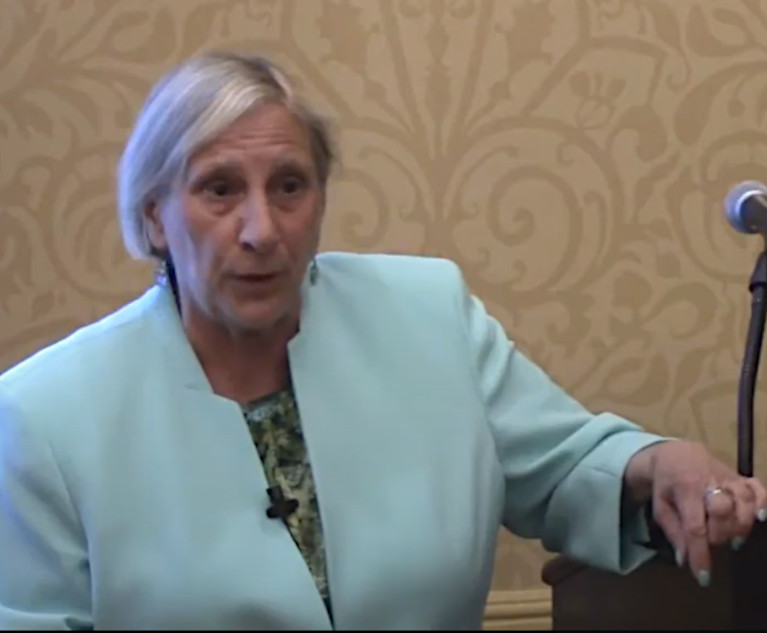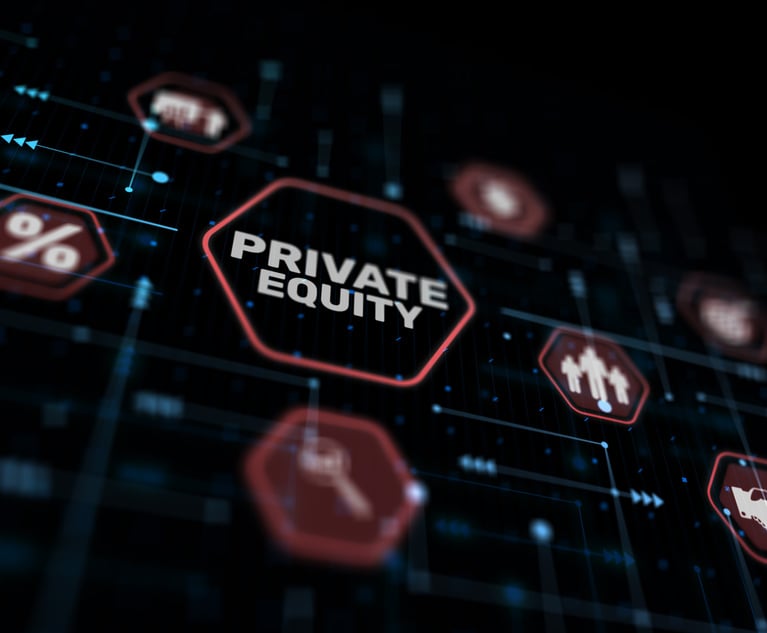New Survey Finds Even Bigger Gender Gap in Big Law Partner Pay
Male partners are earning 53 percent more than female partners in 2018, according to new data. Much of the difference can be attributed to men continuing to originate more business than women.
December 06, 2018 at 09:20 AM
5 minute read
The original version of this story was published on The American Lawyer
 (Photo: pathdoc/Shutterstock.com)
(Photo: pathdoc/Shutterstock.com)
Awareness of the gender pay gap among law firm partners may be rising, thanks in part to a number of high-profile lawsuits. But the pay gap itself?
It may be getting worse.
That's the lesson from a new partner compensation survey out Thursday from Major, Lindsey & Africa. The legal search firm found that male partners are earning $959,000, on average, at large U.S. firms, compared to $627,000 on average for female partners—a 53 percent difference.
In 2010, the first year the biennial survey was conducted, that gap was only 32 percent, and in subsequent years it has fallen between 44 and 48 percent.
Study author Jeffrey Lowe, global practice leader of Major, Lindsey & Africa's law firm practice, cautioned against drawing a stark conclusion that the trend is worsening, noting that the 1,400 to 2,000 partners who have responded in the five iterations of the survey are not fixed. (Survey respondents hail from Am Law 200 and similarly-sized firms across the United States.)
“There could be some response bias,” he said.
But the results do suggest that the problem is not going away, even after firms including Proskauer Rose, Jones Day and Ogletree, Deakins, Nash, Smoak & Stewart have been sued over their imbalances in partner compensation.
The study pins much of the gap on originations. Male partners reported average originations of $2.788 million—a gain of 8 percent over 2016. That compares to $1.589 million for female partners—a decline of 8 percent from 2016.
A statistical analysis of the data, controlling for gender and originations, demonstrated that 75 percent of variation in compensation among partners can be explained by originations and hourly rate and that gender by itself did not have a statistically significant impact on compensation.
“There is definitely a sense, as the report has shown in the last four surveys, that originations tend to direct compensation at most, if not all, firms,” Lowe said. “And there's a feeling among women partners and partners of color that the ability to achieve these originations is more difficult for them.”
He pointed to the relative shortage of mentorship opportunities for members of these groups, as well as the relative absence of people like them to hand down lucrative client relationships.
Another potential explanation for part of the difference is the persistence of unconscious bias that may direct women towards less remunerative practices like labor and employment.
The 2018 study, which was conducted in partnership with legal market research specialist Acritas, for the first time included a focused set of questions on the gender pay gap. Asked whether a gender pay gap was present in their firms, 28 percent of the 1,261 responding partners said yes. Of these, men were far more likely to minimize the effect than women: Only 3 percent of women thought it was 10 percent or less, compared to 21 percent of men. Conversely, 35 percent of female partners believed the gap in pay exceeded 20 percent, compared to 13 percent of male partners.
The response among law firm management to the imbalance has been muted, according to the study, with only 23 percent of 1,248 partners saying their firm management has addressed the possibility of a gender pay gap. Of those respondents, 60 percent said the issue has been discussed in partnership meetings, 52 percent in working groups and 28 percent via internal memoranda.
Nonequity Partners vs. Equity Partners
The study also dug into the distinctions between equity and nonequity partners, with the former earning an average $1.136 million, an increase of 3 percent from 2016, and the latter averaging $371,000, an increase of 1 percent compared to 2016.
That gap dwarfs the difference in billing rates between the two groups: $775 an hour vs. $599 an hour.
It's a reflection of the greater emphasis that firms continue to place on rewarding individual business generators, Lowe said.
For the first time, the 2018 survey looked at the perceived obstacles that nonequity partners face to becoming equity partners. The majority felt generating more business was a barrier, with 64 percent identifying it as the chief obstacle to progression and 79 percent putting it in their top three.
And for nonequity partners who look conclude that the difference between what they bill and what they earn makes them undervalued, tough luck.
“Realistically, there aren't going to be many places that aren't going to be concerned about originations,” Lowe said. “That's just where the industry has gone overall.”
Read More:
Data Snapshot: Is Big Law Making Progress on Gender Diversity?
In Male-Dominated Law Firms, Women Still Reign Over Marketing
Attorney of the Year Finalist David Sanford Is a Force for Equality
This content has been archived. It is available through our partners, LexisNexis® and Bloomberg Law.
To view this content, please continue to their sites.
Not a Lexis Subscriber?
Subscribe Now
Not a Bloomberg Law Subscriber?
Subscribe Now
NOT FOR REPRINT
© 2025 ALM Global, LLC, All Rights Reserved. Request academic re-use from www.copyright.com. All other uses, submit a request to [email protected]. For more information visit Asset & Logo Licensing.
You Might Like
View All
A Plan Is Brewing to Limit Big-Dollar Suits in Georgia—and Lawyers Have Mixed Feelings
10 minute read
HUD Charges Texas HOA With Housing Discrimination in Last Days of Biden Administration
5 minute read
Trending Stories
- 1Litigators of the Week: A $630M Antitrust Settlement for Automotive Software Vendors—$140M More Than Alleged Overcharges
- 2Litigator of the Week Runners-Up and Shout-Outs
- 3Linklaters Hires Four Partners From Patterson Belknap
- 4Law Firms Expand Scope of Immigration Expertise, Amid Blitz of Trump Orders
- 5Latest Boutique Combination in Florida Continues Am Law 200 Merger Activity
Who Got The Work
J. Brugh Lower of Gibbons has entered an appearance for industrial equipment supplier Devco Corporation in a pending trademark infringement lawsuit. The suit, accusing the defendant of selling knock-off Graco products, was filed Dec. 18 in New Jersey District Court by Rivkin Radler on behalf of Graco Inc. and Graco Minnesota. The case, assigned to U.S. District Judge Zahid N. Quraishi, is 3:24-cv-11294, Graco Inc. et al v. Devco Corporation.
Who Got The Work
Rebecca Maller-Stein and Kent A. Yalowitz of Arnold & Porter Kaye Scholer have entered their appearances for Hanaco Venture Capital and its executives, Lior Prosor and David Frankel, in a pending securities lawsuit. The action, filed on Dec. 24 in New York Southern District Court by Zell, Aron & Co. on behalf of Goldeneye Advisors, accuses the defendants of negligently and fraudulently managing the plaintiff's $1 million investment. The case, assigned to U.S. District Judge Vernon S. Broderick, is 1:24-cv-09918, Goldeneye Advisors, LLC v. Hanaco Venture Capital, Ltd. et al.
Who Got The Work
Attorneys from A&O Shearman has stepped in as defense counsel for Toronto-Dominion Bank and other defendants in a pending securities class action. The suit, filed Dec. 11 in New York Southern District Court by Bleichmar Fonti & Auld, accuses the defendants of concealing the bank's 'pervasive' deficiencies in regards to its compliance with the Bank Secrecy Act and the quality of its anti-money laundering controls. The case, assigned to U.S. District Judge Arun Subramanian, is 1:24-cv-09445, Gonzalez v. The Toronto-Dominion Bank et al.
Who Got The Work
Crown Castle International, a Pennsylvania company providing shared communications infrastructure, has turned to Luke D. Wolf of Gordon Rees Scully Mansukhani to fend off a pending breach-of-contract lawsuit. The court action, filed Nov. 25 in Michigan Eastern District Court by Hooper Hathaway PC on behalf of The Town Residences LLC, accuses Crown Castle of failing to transfer approximately $30,000 in utility payments from T-Mobile in breach of a roof-top lease and assignment agreement. The case, assigned to U.S. District Judge Susan K. Declercq, is 2:24-cv-13131, The Town Residences LLC v. T-Mobile US, Inc. et al.
Who Got The Work
Wilfred P. Coronato and Daniel M. Schwartz of McCarter & English have stepped in as defense counsel to Electrolux Home Products Inc. in a pending product liability lawsuit. The court action, filed Nov. 26 in New York Eastern District Court by Poulos Lopiccolo PC and Nagel Rice LLP on behalf of David Stern, alleges that the defendant's refrigerators’ drawers and shelving repeatedly break and fall apart within months after purchase. The case, assigned to U.S. District Judge Joan M. Azrack, is 2:24-cv-08204, Stern v. Electrolux Home Products, Inc.
Featured Firms
Law Offices of Gary Martin Hays & Associates, P.C.
(470) 294-1674
Law Offices of Mark E. Salomone
(857) 444-6468
Smith & Hassler
(713) 739-1250









